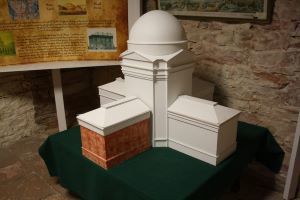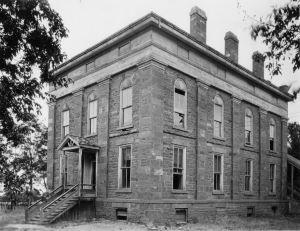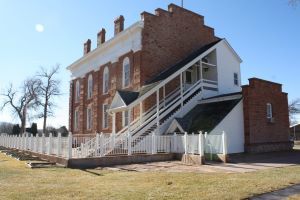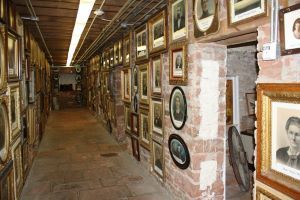Utah's First Territorial Statehouse
Logging Requirements:
1. Read the informational sign directly in front of the stairs that lead to the south side (front) of the building.
2. Locate the initials on the building.
3. Take a picture of the initials on the building. You could take a boring picture or you could be creative in how you do it. You could take a selfie, include members of your party pointing at them, turn the picture into a meme (using a photo editor on your phone to add text, etc. to it) or any other creative idea you come up with.
4. Send that picture to us via the messages or an email. DO NOT POST that picture.
5. Not required, but encouraged: Take additional unique, fun, creative pictures of the building or other interests found in the park and post those in your log.
I have great memories of the many times I've visited this building through my life. One that especially stands out is when my mom and I came to visit the museum when I was around 13. My mom told the docent the names of several of our ancestors who settled in the area and the lady told us about a few special items to look for that had belonged to our ancestors. A little while later she found us and said she had been thinking and realized there was at least one thing in every room of the museum from our ancestors and proceded to give us a personal tour.
I love that this building has so much history which you can read more about below. I also love that my family contributed so much to the area and that our family can, 100+ later, see artifacts used in their daily lives, some that they crafted with their own hands, purchased with hard-earned money and some belongings that were obtained by trading for labor, eggs, fruits and veggies and more.
And, one to not be left out, Josh has an ancestor who also helped settle Fillmore. We didn't know this until we were posing for a picture next to one of my ancestor's headstones (why we were doing that, I do not remember and it seems like an odd thing for me to do, but alas, I have the photo proof that we did) in the Fillmore cemetery after we were newly married and I looked over and saw a headstone on the other side of me with the surname Partridge and I got all excited because it was an ancestor of Josh's. He had no idea, but I done a bit of research on his ancestors. Our grandparents are buried next to each other in the cemetery! I just love that!
My father was born in a house built by my mother's ancestors that later served as a maternity home and is on the other side of Main Street from the museum. My mother was also born in Fillmore, but at that time (4 years later), they had built an actual hospital.
Enough about me. You are here to experience the Statehouse and here I am blubbering about personal things.
While you are here, be sure to do the Adventure Lab and multi-cache.
There are many great news stories and articles and even many books contain written history of this beautiful and majestic building. The information below are excerpts from an article in the St. George News Archives.
Some of the History of this Beautiful and Majestic Territorial Statehouse
For a few years, believe it or not, Fillmore was the official capital of Utah – a Utah very different than the one today.
The whole reason for the settlement of Fillmore in October 1851 was to eventually turn it into the seat of government for the newly-recognized territory. Brigham Young, both president of The Church of Jesus Christ of Latter-day Saints and governor of the Utah Territory at the time, foresaw what was then known as Pahvant Valley as a major population center. He chose the site of the future city because it was smack dab in the middle of the territory, whose boundaries back then encompassed most of what is now the state of Nevada.
A few months before the town’s establishment, anti-Mormon U.S. President Zachary Taylor had died, leaving Millard Fillmore, his vice president, as his successor. The new president was much more kind toward the Mormons and his administration approved Utah’s drive to become a territory not too long after assuming power.
As a “gift” to the new president, Young selected Fillmore as the name for the town and Millard as the moniker for the county, which at that time extended all the way to the California border. The adulation worked, apparently, since the Fillmore administration appropriated $20,000 to build a capitol building in Fillmore, albeit the amount was less than appropriations given to other territories.
Establishing a new settlement so late in the year definitely had its disadvantages. Many first-year settlers spent the winter in their wagons and those who were able to built quick cabins using cottonwood logs.

The original design for the statehouse, drawn up by Truman O. Angell, architect for the Salt Lake Temple and Young’s brother-in-law, envisioned a grand four-winged structure with a domed cupola in the middle. To say it didn’t quite work out as planned is a major understatement.
Unfavorable weather, trouble with Native Americans, lack of decent transportation and squabbling over funding all took their toll and slowed the construction schedule. Another big issue that had to be addressed was building an approximately 6-mile road up Chalk Creek to a quarry where sandstone could be easily cut for the building’s walls.
Started in 1851, it took until 1854 just to finish the basement. Working at a breakneck pace compared to early construction, the stonework for the other two floors went up in three months and it took a full year to complete the interior, Camp noted. The building was completed in time for the territory’s Legislature to meet in late 1855 in what was just the south wing of the building originally planned.
“The early settlers worked long hard hours to build it,” said the late Fred Hayes, who served as director of the Utah State Parks and Recreation Division. Hayes spent the early part of his career at the Statehouse.
“They were pretty proud of their efforts, and many even carved initials and symbols in the stonework,” he said. “It kind of became a symbol of their struggle to make something out of nothing, which in reality is the story of the early settlers of the Utah Territory.”
That December 1855-January 1856 session was the only full legislative session held in the building. Brigham Young and legislators quickly realized that the distance from the real population center, what was then known as Great Salt Lake City, approximately 150 miles north, was too much (it often took four days to travel to or from Fillmore) and the small town was not fit to temporarily accommodate all the members of the Legislature.

One good thing the Statehouse brought the town was an excellent venue for dances. Even before the building was finished, settlers regularly held dances that lasted until midnight.
Besides hosting the Legislature, the building did become the hiding place and base of operations for the Deseret News for a few months during the Utah War, when, in 1857, President James Buchanan sent troops led by General Albert Sidney Johnston to supposedly quell what was perceived as a Mormon insurrection against the government.
An extremely short session in 1858 was the last time the building was used by the Legislature. The sole purpose of that meeting was to assemble in what was still legally recognized as the territorial capital to vote to officially move the capital back to Salt Lake City to appease the new federally-appointed governor.
After its short-lived stint as the territory’s capitol, the Territorial Statehouse served many different purposes, mainly as a school and a social hall. One of the schools in the building during the 1880s was a Presbyterian Mission School whose main aim was to discourage children from practicing polygamy in the future. It didn’t quite achieve that goal, but at least it gave the children a good education.
“It hosted lots of odds and ends,” Camp said of the structure, adding that it served as a jail, law offices, library, photography studio and a hall for the American Legion, which was the only organization on record during that time period to make any improvements to the building – adding another layer to the floor on the top story in 1917.

This historic photo shows what the Territorial Statehouse looked like around the turn of the 20th Century, Fillmore, Utah, circa 1901-1927 | Photo courtesy of Utah State Historical Society, St. George News
After the turn of the 20th century, the building fell into disrepair. Just over 30 years after its construction, the Presbyterian Mission School complained about the need to replace some windows and repaint in some places. Later on, local children would crawl in the broken windows and use the basement as a hideout. Considered for demolition, the Daughters of Utah Pioneers stepped in to stop any such thought in 1928. Not wanting to see the important historical relic gone forever, the organization approached the state to fund the renovation.
When it came to the DUP member who was a major impetus for the renovation, Mame Dame, and her attempts to get funding, Camp joked that she “didn’t hear you when you said no.”
With the help of the state, the DUP restored the building and turned it into a museum in 1930. Members of the DUP operated the museum, and the state parks commission paid the bills, which is why it can lay claim to the title of Utah’s first state park. Camp said to this day there is confusion as to which collections are the DUP’s and which are the state’s since they didn’t keep good records.
In 1957, the museum fell under the auspices of the newly created State Parks and Recreation Division and has been operated by it ever since.
Later trials and threats
Even though the Territorial Statehouse was the state’s first government building, the oldest government building still standing west of the Missouri River and the state’s first state park, it sometimes hasn’t pleased state legislatures, because it does not draw many annual visitors and thus does not make much revenue.
Most state parks are recreation-oriented and many – especially those that have a reservoir for boating and water sports – actually make the state money.
“Our heritage parks don’t ever do that,” Camp said. “We’re not making the money.”
There have been times the legislature has seriously considered closing the statehouse because they’ve felt like it’s a drain on the State Parks and Recreation Division’s budget.
In the late 1990s, one legislator even joked that the park would do better if a representative stood outside the building and handed out $5 bills to anyone coming to visit and told them to move on. A former park manager even said the Statehouse did not make a good museum and that a new museum should be built to house its artifacts in order to return the building to its original purpose as some sort of government office.
While the Statehouse has been maligned and put on the chopping block several times, it has obviously never been closed down.
“When they really think about it, they realize it is a very important part of our history,” Camp said of the state legislature’s decision to keep the park open.
Hayes concurred: “I think Territorial Statehouse has such ‘staying power’ simply because of the amazing story it tells about Utah’s struggle to get going.”
The Huntsman connection and revival
Jon M. Huntsman, Jr. has deep roots in Fillmore. His fourth great-grandparents were among its first settlers.
After Huntsman was elected Utah’s governor in 2004, knowing that the State Capitol would be under renovation, he decided to deliver his first State of the State address in Fillmore at the Territorial Statehouse to give the oft-forgotten relic another day in the sun. Not only did Huntsman have an affinity for the place because of his family connections, he said he wanted to get out among Utahns not living along the Wasatch Front.
In a “Salt Lake Tribune” article three days before the event, Huntsman said that he might be “a little bit unstable” during the speech because of the emotion the town evokes for him.
“My whole family tree is represented in Fillmore,” Huntsman said. “It’s where I learned how to drive a car, learned how to shoot a gun, fish.”
Huntsman’s decision to give the speech in Fillmore caused quite a stir. Just as with legislators of old, some members of the state Legislature at the time grumbled at the thought of having to travel 150 miles for an event usually held in their backyard. Some refused to attend and did end up boycotting the event, saying it was a waste of taxpayer money to stage it so far from the capital.
Event organizers asked Camp to pull portraits of Huntsman ancestors from the museum’s hall of portraits in its basement to be put on display during the speech. Camp informed them that there were roughly 30-40 pictures of Huntsman’s forebears on the wall, which would be overkill. In the end, Camp ended up displaying eight portraits – only those with the last name of Huntsman.
Camp said the event, which happened on Jan. 20, 2005, revived interest in the Statehouse, causing a short-lived uptick in visitation. To commemorate Huntsman and to provide visitors with something many of them could relate to, the museum put together a display about Huntsman in one of the rooms on the museum’s middle floor.
Camp said just over 9,000 visitors came through the door in 2017, but approximately 3,000 enjoyed July 4 festivities and another 6,000 participated in the September festival.
But one thing Camp and most visitors can agree on is the 162-year old building is a gem.
Visiting the Territorial Statehouse
Visitors enter from a small addition to the building on the northeast corner. Once inside, the staff will tell visitors to expect uneven floors, especially in the basement, which feels dungeon-esque with all its exposed stone. The basement contains the hall of portraits and the Deseret News printing press exhibit among others. The Huntsman room is on the middle story, whose floors are a little uneven as well.
The showcase is easily the top floor (arrived at by a steep set of of narrow stairs originating from the room in the southwest corner of the middle floor), the large room where most of the action happened in the building – where the Legislature met and where seemingly innumerable dances and social gatherings occurred.
One cannot help but imagine what it must have been like to see the Legislature at work or attend one of the late night dances in the room. And to the former legislative chamber’s credit, its well-finished wooden floors do not feel uneven.
For more information on the Territorial Statehouse State Park Museum, go to their website.
Author’s Note: This story was originally published on January 28, 2018. Since then, Fred Hayes, the Director of the Utah Division of Parks and Recreation quoted in the story, has passed away.



Virtual Rewards 3.0 - 2022-2023
This Virtual Cache is part of a limited release of Virtuals created between March 1, 2022 and March 1, 2023. Only 4,000 cache owners were given the opportunity to hide a Virtual Cache. Learn more about Virtual Rewards 3.0 on the Geocaching Blog.